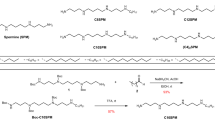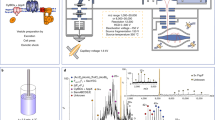Abstract
We describe a method that allows for the concurrent proteomic analysis of both membrane and soluble proteins from complex membrane-containing samples. When coupled with multidimensional protein identification technology (MudPIT), this method results in (i) the identification of soluble and membrane proteins, (ii) the identification of post-translational modification sites on soluble and membrane proteins, and (iii) the characterization of membrane protein topology and relative localization of soluble proteins. Overlapping peptides produced from digestion with the robust nonspecific protease proteinase K facilitates the identification of covalent modifications (phosphorylation and methylation). High-pH treatment disrupts sealed membrane compartments without solubilizing or denaturing the lipid bilayer to allow mapping of the soluble domains of integral membrane proteins. Furthermore, coupling protease protection strategies to this method permits characterization of the relative sidedness of the hydrophilic domains of membrane proteins.
This is a preview of subscription content, access via your institution
Access options
Subscribe to this journal
Receive 12 print issues and online access
$209.00 per year
only $17.42 per issue
Buy this article
- Purchase on Springer Link
- Instant access to full article PDF
Prices may be subject to local taxes which are calculated during checkout





Similar content being viewed by others
References
Alberts, B. et al. Molecular Biology of the Cell (Garland Science, New York, 2002).
Santoni, V., Molloy, M. & Rabilloud, T. Membrane proteins and proteomics: un amour impossible? Electrophoresis 21, 1054–1070 (2000).
Washburn, M.P., Wolters, D. & Yates, J.R., III. Large-scale analysis of the yeast proteome by multidimensional protein identification technology. Nat. Biotechnol. 19, 242–247 (2001).
Han, D.K., Eng, J., Zhou, H. & Aebersold, R. Quantitative profiling of differentiation-induced microsomal proteins using isotope-coded affinity tags and mass spectrometry. Nat. Biotechnol. 19, 946–951 (2001).
Blonder, B. et al. Enrichment of integral membrane proteins for proteomic analysis using liquid chromatography–tandem mass spectrometry. J. Proteome Res. 1, 351–360 (2002).
Goshe, M.B., Blonder, B. & Smith, R.D. Affinity labeling of highly hydrophobic integral membrane proteins for proteome-wide analysis. J. Proteome Res. 2, 153–161 (2003).
Zhou, H., Watts, J.D. & Aebersold, R. A systematic approach to the analysis of protein phosphorylation. Nat. Biotechnol. 19, 375–378 (2001).
Oda, Y., Nagasu, T. & Chait, B.D. Enrichment analysis of phosphorylated proteins as a tool for probing the phosphoproteome. Nat. Biotechnol. 19, 379–382 (2001).
Goshe, M.B. et al. Phosphoprotein isotope-coded affinity tag approach for isolating and quantitating phosphopeptides in proteome-wide analysis. Anal. Chem. 73, 2578–2586 (2001).
Ficarro, S.B. et al. Phosphoproteome analysis by mass spectrometry and its application to Saccharomyces cerevisiae. Nat. Biotechnol. 20, 301–305 (2002).
MacCoss, M.J. et al. Shotgun identification of protein modifications from protein complexes and lens tissue. Proc. Natl. Acad. Sci. USA 99, 7900–7905 (2002).
Cheeseman, I.M. et al. Phospho-regulation of kinetochore–microtubule attachments by the aurora kinase ipl1p. Cell 111, 163–172 (2002).
Howell, K.E. & Palade, G.E. Hepatic Golgi fractions resolved into membrane and content subfractions. J. Cell Biol. 92, 822–832 (1982).
Taylor, R.S. et al. Proteomics of rat liver Golgi complex: minor proteins are identified through sequential fractionation. Electrophoresis 21, 3441–3459 (2000).
Blobel, G. & Sabatini, D.D. Controlled proteolysis of nascent polypeptides in rat liver cell fractions. I. Location of the polypeptides within ribosomes. J. Cell Biol. 45, 130–145 (1970).
Sabatini, D.D. & Blobel, G. Controlled proteolysis of nascent polypeptides in rat liver cell fractions. II. Location of the polypeptides in rough microsomes. J. Cell Biol. 45, 146–157 (1970).
Link, A.J. et al. Direct analysis of protein complexes using mass spectrometry. Nat. Biotechnol. 17, 676–682 (1999).
MacCoss, M.J., Wu, C.C. & Yates, J.R., III. Probability-based validation of protein identifications using a modified SEQUEST algorithm. Anal. Chem. 74, 5593–5599 (2002).
Moller, S., Croning, M.D.R. & Apweiler, R. Evaluation of methods for the prediction of membrane-spanning regions. Bioinformatics 17, 646–653 (2001).
Wallin, E. & von Heijne, G. Genome-wide analysis of integral membrane proteins from eubacterial, archaean, and eukaryotic organisms. Protein Sci. 7, 1029–1038 (1998).
Blom, N., Gammeltoft, S. & Brunak, S. Sequence and structure-based prediction of eukaryotic protein phosphorylation sites. J. Mol. Biol. 294, 1351–1362 (1999).
Foletti, D.L., Lin, R., Finley, M.A. & Scheller, R.H. Phosphorylated syntaxin 1 is localized to discrete domains along a subset of axons. J. Neurosci. 20, 4535–4544 (2000).
Madrid, R. et al. Polarized trafficking and surface expression of the AQP4 water channel are coordinated by serial and regulated interactions with different clathrin–adaptor complexes. EMBO J. 20, 7021 (2001).
Zelenina, M., Zelenin, S., Bondar, A.A., Brismar, H. & Aperia, A. Water permeability of aquaporin-4 is decreased by protein kinase C and dopamine. Am. J. Physiol. Renal Physiol. 283, F309–F318 (2002).
Sprong, H. et al. UDP-galactose:ceramide galactosyltransferase is a class I integral membrane protein of the endoplasmic reticulum. J. Biol. Chem. 237, 25880–25888 (1998).
Ring, G. & Eichler, J. Characterization of inverted membrane vesicles from the halophilic archaeon Haloferax volcanii. J. Membr. Biol. 183, 195–204 (2001).
Kawano, J. et al. CALNUC (nucleobindin) is localized in the Golgi apparatus in insect cells. Eur. J. Cell Biol. 79, 16167–16173 (2000).
Morel-Huaux, V.M. et al. The calcium-binding protein p54/NEFA is a novel luminal resident of medial Golgi cisternae that trafficks independently of mannosidase II. Eur. J. Cell Biol. 81, 87–100 (2002).
Taylor, R.S., Jones, S.M., Dahl, R.H., Nordeen, M.H. & Howell, K.E. Characterization of the Golgi complex cleared of proteins in transit and examination of calcium uptake activities. Mol. Biol. Cell 8, 1911–1931 (1997).
Wen, D.X., Svensson, E.C. & Paulson, J.C. Tissue-specific alternative splicing of the β-galactoside α2,6- sialyltransferase gene. J. Biol. Chem. 267, 2512–2518 (1992).
Florens, L. et al. A proteomic view of the Plasmodium falciparum life cycle. Nature 419, 520–526 (2002).
Pierce, K.L., Premont, R.T. & Lefkowitz, R.J. Seven-transmembrane receptors. Nat. Rev. Mol. Cell Biol. 3, 639–650 (2002).
Oda, Y., Huang, K., Cross, F.R., Cowburn, D. & Chait, B.T. Accurate quantitation of protein expression and site-specific phosphorylation. Proc. Natl. Acad. Sci. USA 96, 6591–6596 (1999).
Washburn, M.P., Ulaszek, R., Deciu, C., Schieltz, D.M. & Yates, J.R., III. Analysis of quantitative proteomic data generated via multidimensional protein identification technology. Anal. Chem. 74, 1650–1657 (2002).
Gygi, S.P. et al. Quantitative analysis of complex protein mixtures using isotope-coded affinity tags. Nat. Biotechnol. 17, 994–999 (2000).
Eng, J.K., McCormack, A.L. & Yates, J.R., III. An approach to correlate tandem mass spectral data of peptides with amino acid sequences in a protein database. J. Am. Soc. Mass Spectrom. 5, 976–989 (1994).
Tabb, D.L., McDonald, W.H. & Yates, J.R., III. DTASelect and Contrast: tools for assembling and comparing protein identifications from shotgun proteomics. J. Proteome Res. 1, 21–26 (2002).
Roepstorff, P. & Fohlman, J. Proposal for a common nomenclature for sequence ions in mass spectra of peptides. Biomed. Mass Spectrom. 11, 601 (1984).
Acknowledgements
The authors gratefully acknowledge financial support from the American Cancer Society PF-03-065-01-MGO (C.C.W.) and the National Institute of Health grants F32DK59731 (M.J.M.), RO1-GM42629 (K.E.H) and R33 CA81665 and RR11823 (J.R.Y.).
Author information
Authors and Affiliations
Corresponding author
Ethics declarations
Competing interests
The authors declare no competing financial interests.
Rights and permissions
About this article
Cite this article
Wu, C., MacCoss, M., Howell, K. et al. A method for the comprehensive proteomic analysis of membrane proteins. Nat Biotechnol 21, 532–538 (2003). https://doi.org/10.1038/nbt819
Received:
Accepted:
Published:
Issue Date:
DOI: https://doi.org/10.1038/nbt819
This article is cited by
-
PRMxAI: protein arginine methylation sites prediction based on amino acid spatial distribution using explainable artificial intelligence
BMC Bioinformatics (2023)
-
Glycoproteomic analysis of the changes in protein N-glycosylation during neuronal differentiation in human-induced pluripotent stem cells and derived neuronal cells
Scientific Reports (2021)
-
Comparative Proteomics Analysis of Four Commonly Used Methods for Identification of Novel Plasma Membrane Proteins
The Journal of Membrane Biology (2019)
-
Comparative characterization of rat hippocampal plasma membrane and mitochondrial membrane proteomes based on a sequential digestion-centered combinative strategy
Analytical and Bioanalytical Chemistry (2018)
-
Insight of brain degenerative protein modifications in the pathology of neurodegeneration and dementia by proteomic profiling
Molecular Brain (2016)



